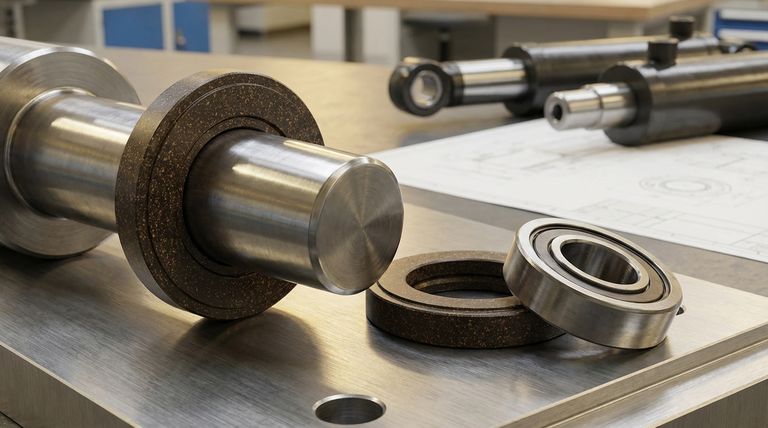For demanding wear applications, the preferred composition is a compound of Polytetrafluoroethylene (PTFE) filled with bronze powder, often supplemented with other friction-reducing additives. This formulation dramatically improves the material's mechanical properties, specifically its resistance to wear and its ability to handle high loads and speeds. It serves as an exceptional self-lubricating replacement for metal components that would otherwise require frequent maintenance.
The core takeaway is that adding bronze to PTFE creates a composite material that sacrifices the ultra-low friction of pure PTFE for a massive gain in wear resistance, load-bearing capacity, and heat dissipation, making it ideal for mechanical components like bearings and seals.

Why Bronze is the Standard Filler for Wear Resistance
Virgin PTFE is exceptionally slick but mechanically weak. For applications involving significant pressure or repetitive motion, fillers are essential to reinforce the polymer matrix. Bronze has become the industry standard for this purpose.
A Leap in Mechanical Strength
The inclusion of bronze particles significantly increases the hardness and compressive strength of the PTFE. This reinforcement prevents the material from deforming or "creeping" under sustained load, a common failure point for unfilled polymers.
Improving the PV Value
The PV (Pressure-Velocity) value is a critical metric for bearing materials, defining the maximum combination of pressure and surface speed a material can withstand before failing. Bronze-filled PTFE has a much higher PV rating than pure PTFE, allowing it to perform reliably in more demanding dynamic applications.
Enhancing Thermal Conductivity
Friction generates heat. Bronze is an excellent thermal conductor, and adding it to the PTFE matrix allows this frictional heat to be drawn away from the contact surface. This prevents heat buildup, which can cause thermal expansion and accelerate wear.
Common Applications in Industry
The unique properties of bronze-filled PTFE make it a go-to material for a range of self-lubricating mechanical parts.
Slideway Bearings and Wear Strips
In the machine tool industry, these components replace traditional lubricated metal guides. They are also used in sub-assemblies like shock absorber struts, providing a smooth, durable, and maintenance-free sliding surface.
Piston Rings and Seals
Used in hydraulic and pneumatic cylinders, bronze-filled PTFE piston rings provide an effective seal while absorbing the wear from continuous motion. Their self-lubricating nature is critical in these systems.
Bushings and Wear Plates
These components can be machined from solid stock or applied as a layer on metal bushings. They create robust, self-lubricating joints for rotating or oscillating shafts, especially in heavy-duty equipment where thick wear plates are required.
Understanding the Trade-offs
While bronze-filled PTFE offers superior performance in many areas, it is not a universal solution. Understanding its limitations is key to successful application.
The Increase in Friction
The primary trade-off is a higher coefficient of friction compared to virgin PTFE. While still very low, the hardness of the bronze particles means it is not as slick as the pure, unfilled polymer.
Reduced Chemical Resistance
The PTFE matrix itself remains highly inert. However, the bronze filler is not. It can be attacked by certain acids, bases, or other corrosive agents. In chemically aggressive environments, the compatibility of the bronze must be considered.
Abrasiveness on Soft Mating Surfaces
The hard bronze particles can be abrasive to softer counter-surfaces, such as shafts made from aluminum or brass. For optimal performance, bronze-filled PTFE should be run against a hard surface, like hardened steel.
Making the Right Choice for Your Goal
Selecting the correct material composition requires aligning its properties with the primary demands of your application.
- If your primary focus is maximum wear resistance and load capacity: Bronze-filled PTFE is the definitive choice for most mechanical bearing and slide applications.
- If your primary focus is the absolute lowest friction: Unfilled PTFE or a compound with graphite or MoS₂ may be more suitable, provided the mechanical loads are low.
- If your primary focus is chemical compatibility in a wear application: Consider PTFE filled with more inert materials, such as glass fiber or carbon, which offer good mechanical properties without the chemical reactivity of bronze.
By understanding these fundamental trade-offs, you can specify a PTFE compound precisely engineered for your specific mechanical challenge.
Summary Table:
| Property | Pure PTFE | Bronze-Filled PTFE |
|---|---|---|
| Wear Resistance | Low | Very High |
| Load Capacity | Low | High |
| Coefficient of Friction | Extremely Low | Low |
| Thermal Conductivity | Low | High |
| Chemical Resistance | Excellent | Good (Bronze is reactive) |
Need a custom PTFE component that balances wear resistance, load capacity, and self-lubrication?
KINTEK specializes in manufacturing high-performance PTFE components, including bronze-filled seals, bearings, and wear plates, for the semiconductor, medical, laboratory, and industrial sectors. Our precision production and custom fabrication services—from prototypes to high-volume orders—ensure you get a component perfectly engineered for your specific mechanical challenges.
Contact our experts today to discuss your application and receive a quote!
Visual Guide

Related Products
- Customizable PTFE Seals Filter Holders for Versatile Applications
- Custom PTFE Sleeves and Hollow Rods for Advanced Applications
- Custom PTFE Measuring Cylinders for Advanced Scientific and Industrial Applications
- Custom PTFE Parts Manufacturer for Teflon Containers and Components
- Custom PTFE Parts Manufacturer for Teflon Parts and PTFE Tweezers
People Also Ask
- What material is the PTFE bottle made from? Discover the Benefits of 100% Virgin PTFE
- How does PTFE perform in chemically corrosive environments? Unmatched Chemical Immunity & Reliability
- What are the chemical resistance properties of PTFE labware? The Ultimate Guide to Inert Labware
- How do PTFE-lined valves prevent leakage and contamination? Ensure Purity and Protect Equipment
- What factors should be considered when choosing between PTFE lined and hard seal butterfly valves? Ensure Optimal Performance and Safety



















